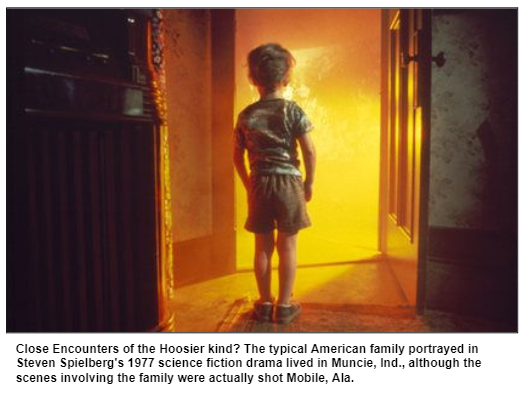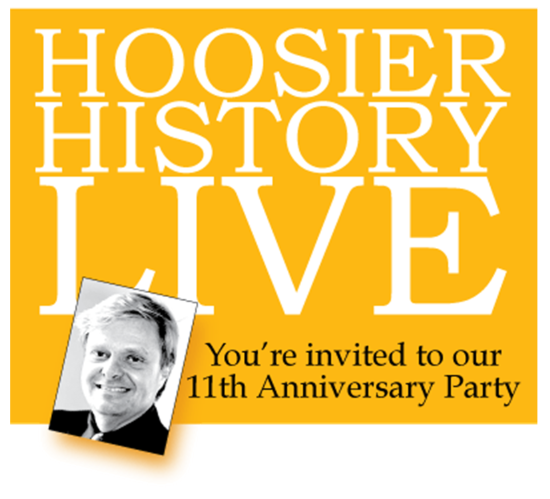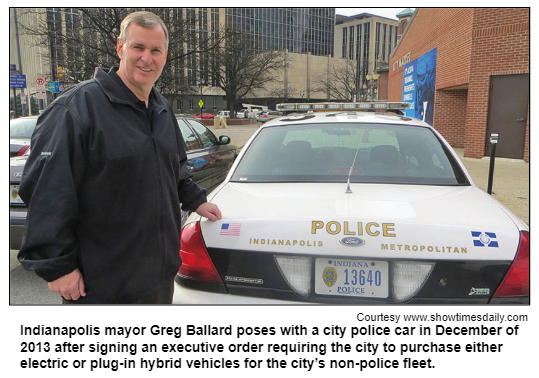
Saturdays, noon to 1 p.m. ET on WICR 88.7 FM.
Or listen live from anywhere on WICR Online!
Our call-in number during the show: (317) 788-3314
February 16, 2019
Movies with obscure Indiana connections
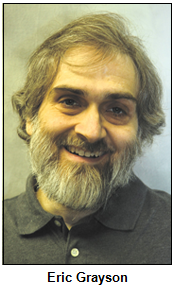 Even though Close Encounters of the Third Kind was considered a blockbuster after its release in 1977, many Hoosiers may have forgotten its connection to Indiana. No scenes were filmed in the state, but the central characters were described as residents of Muncie.
Even though Close Encounters of the Third Kind was considered a blockbuster after its release in 1977, many Hoosiers may have forgotten its connection to Indiana. No scenes were filmed in the state, but the central characters were described as residents of Muncie.
In a scene played for laughs in Brother from Another Planet (1984), the protagonist, an alien who doesn't speak, encounters wide-eyed tourists from Indiana on a subway in New York City.
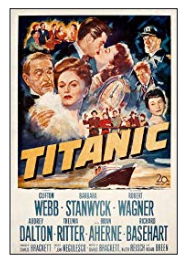
In the 1953 version of the film Titanic, a fictional passenger on the doomed ocean liner is a student at Purdue University. Played by Robert Wagner, the character is described as a college tennis star.
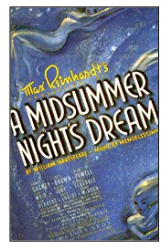
In addition to talking about movies with obscure links to Indiana, during our show Eric will share insights about actors and directors with Hoosier connections who - unlike the more famous James Dean, Steve McQueen, Carole Lombard and other stars - are seldom discussed today.

They include Otis Harlan (1865-1940), a comedian and character actor from Martinsville. According to Eric, Harlan was featured in hundreds of silent movies and early talkies, including a film version of A Midsummer Night's Dream (1935). Harlan also provided the voice of the dwarf Happy in Disney's animated Snow White and the Seven Dwarfs (1937).
Richmond native Norman Foster (1903-1976), an actor who enjoyed greater success when he became a director, also was involved in Disney projects. Foster was associated with Orson Welles for many decades, serving as the director of the spy thriller Journey into Fear (1943) starring Welles, as well as several Charlie Chan mysteries. As an actor, Foster had a major role in Welles' final movie, The Other Side of the Wind, which began filming in 1970; it was uncompleted when Welles died in 1985 and finally was released in 2018 after being reconstructed by other filmmakers.
Both Foster and Harlan were in the cast of The Hoosier Schoolmaster (1935), a movie based on a 19th-century novel by Indiana author Edward Eggleston. The setting is southern Indiana after the Civil War.
Please note: This show was original scheduled for January 12 but had to be rescheduled due to severe weather.
History Mystery

A major Hollywood movie released in 1988 was set in Chicago, but many significant scenes actually were filmed in Indianapolis during the previous year.
The film's plot focuses on one of the most notorious scandals in baseball history. In 1919, Chicago White Sox players accepted bribes to lose the World Series. The movie, which starred John Cusack and Charlie Sheen, follows the unfolding of what became known as the "Black Sox scandal."
Historic Bush Stadium, still the home of the Indianapolis Indians during the 1980s, was the setting for many of the baseball sequences in the movie, standing in for the home field of the 1919 White Sox.Question: What was the name of the baseball movie filmed at Bush Stadium?
Please do not call in to the show until you hear Nelson pose the question on the air, and please do not try to win if you have won any other prize on WICR during the last two months. You must be willing to give your first name to our engineer, you must answer the question correctly on the air and you must be willing to give your mailing address to our engineer so we can mail the prize pack to you. The prize this week is a dvd of the newly remastered film Little Orphant Annie starring Colleen Moore and restored by Eric Grayson, courtesy of Eric Grayson. Don’t miss this opportunity to win a copy of this cinematic treasure telling the story of a beloved James Whitcomb Riley poem!
An affair to remember...
Join us February 28 for our anniversary soiree!
- When: Thursday, Feb. 28, 2019, from 5 to 7:30 p.m.
- Where: Indiana Landmarks Center, 1201 Central Ave., Indianapolis, IN 46202.
- RSVP by clicking here, please.
Legendary Hoosier Bobby Plump, who made the final, winning shot for the small Milan High School basketball team in 1954, will speak. Musical performance by Herron High School Strings and PrairieTown.
You are welcome to come in historic garb, or to dress representing your proud ethnic heritage.
Live History Mystery from the podium by host Nelson Price. Delicious catered cuisine and cash bar provided by Black Plate Catering. This is a complimentary event. However, as we are a small independent production group, we appreciate your visiting the yellow "donate" button on our website or newsletter. Or, if you wish, bring a check made out to Hoosier History Live to the event.
We look forward to seeing you!
Thanks to our sponsors!
Christmas is long past, but here's a Hoosier History Live wish list

Hoosier History Live is seeking a restaurant sponsor near UIndy, Fountain Square, or downtown. We like to treat our studio guests to lunch after the Saturday show, and we will offer a complimentary sponsorship in exchange for the opportunity to bring our guests to your restaurant to dine and to chat!
We like prizes for the History Mystery contest, too, ideally items that can be mailed in a standard business envelope. In return we will feature your logo and a link to your organization's home page in our newsletter and on our website, and a mention by Nelson on the air.
Also, if your business or organization would like to start a listening group during the live show, all you need is a quiet room and a radio, laptop or listening device and someone to facilitate the group. The Irvington Library has maintained a listening group open to the public for about eight years. This is a great opportunity for small busineses, libraries, or senior centers.
For all of the above, contact producer Molly Head at molly@hoosierhistorylive.org
Nelson Price, host and historian
Molly Head, producer/project manager, (317) 927-9101
Michael Armbruster, associate producer
Cheryl Lamb, administrative manager
Richard Sullivan, senior tech consultant
Pam Fraizer, graphic designer
Garry Chilluffo, special events consultant
Please tell our sponsors that you appreciate their support!

 Acknowledgments to Monomedia, Visit Indy, WICR-FM, Fraizer Designs, Heritage Photo & Research Services, Henri Pensis, Aaron Duvall, Chloe Tyson, and many other individuals and organizations. We are independently produced and are self-supporting through organizational sponsorship and through individual contribution at the yellow button on our newsletter or website. For organizational sponsorship, which includes logos, links, and voiced credits in the show, contact Molly Head at (317) 927-9101 or email her at molly@hoosierhistorylive.org. Our media reach continues to grow via podcasting and iTunes.
Acknowledgments to Monomedia, Visit Indy, WICR-FM, Fraizer Designs, Heritage Photo & Research Services, Henri Pensis, Aaron Duvall, Chloe Tyson, and many other individuals and organizations. We are independently produced and are self-supporting through organizational sponsorship and through individual contribution at the yellow button on our newsletter or website. For organizational sponsorship, which includes logos, links, and voiced credits in the show, contact Molly Head at (317) 927-9101 or email her at molly@hoosierhistorylive.org. Our media reach continues to grow via podcasting and iTunes.
Thank you!
We'd like to thank the following recent, new and renewal contributors whose donations help make this show possible!
- Serita Borgeas
- Margaret Sabens
- Marjorie and James Kienle
- Robin Jarrett
- Susan Orr
- Jennifer Q. Smith
- Wendy Boyle
February 23, 2019 - coming up
Former Indy Mayor Ballard on electric car history and more
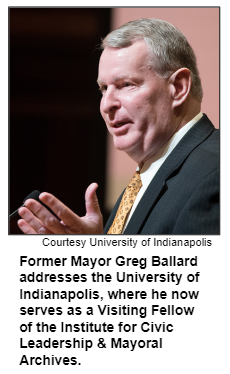
Former Mayor Ballard will describe his new role, reflect on his terms as mayor (which followed an unexpected victory in the 2007 election) and talk about historic aspects of one of his major areas of focus - electric cars - when he joins Nelson as studio guest.
Indiana-related aspects of electric car production involve modern history: During the 1990s, crucial components of General Motors' EV1, described as "one of the most technologically advanced" and fuel-efficient vehicles of the 20th Century, were made in two Indiana cities. A Delco Remy plant in Anderson produced the motors. The battery packs were made in Muncie, also at a Delco Remy factory.
The need to shift from oil as the primary transportation fuel is the focus of Less Oil or More Caskets (IU Press), a new book by former Mayor Ballard, who draws on observations from his 23-year career as a U.S. Marine, which included serving in the first Persian Gulf War.
In 2013, while serving as mayor, Greg Ballard was our studio guest to discuss historic connections between the Marines and the Hoosier state. He also shared insights about attending Cathedral High School (where he was a member of the Class of '72) during its final years as an all-male school located in downtown Indy.
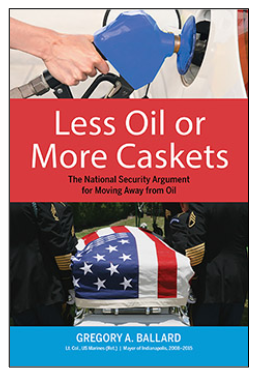
Documents, oral interviews and artifacts of former mayors are housed at UIndy's Institute for Civic Leadership & Mayoral Archives. Several former mayors, including Ballard's predecessor, Bart Peterson, a Democrat, have served on UIndy's board of trustees (Former Mayor Peterson was Nelson's studio guest on a show in 2015).
The history of electric cars stretches much further back than the 1990s production of the EV1. Early electric vehicles - powered by a battery charged by plugging it in - were built circa 1900 at the dawn of auto production.
As Ballard describes in his book, the challenges then involved the limitations of the vehicles; in the early 1900s, electric cars only could travel about 20 miles before requiring a recharge, severely limiting their range compared to gasoline-powered automobiles.
With substantial improvements in battery technology since that time, electric cars have made significant gains in range and efficiency. Less Oil or More Caskets is being promoted as a call to action to shift from gasoline to electricity in transportation, which former Mayor Ballard calls "the last industry dominated by the use of oil."
© 2019 Hoosier History Live. All rights reserved.
|
